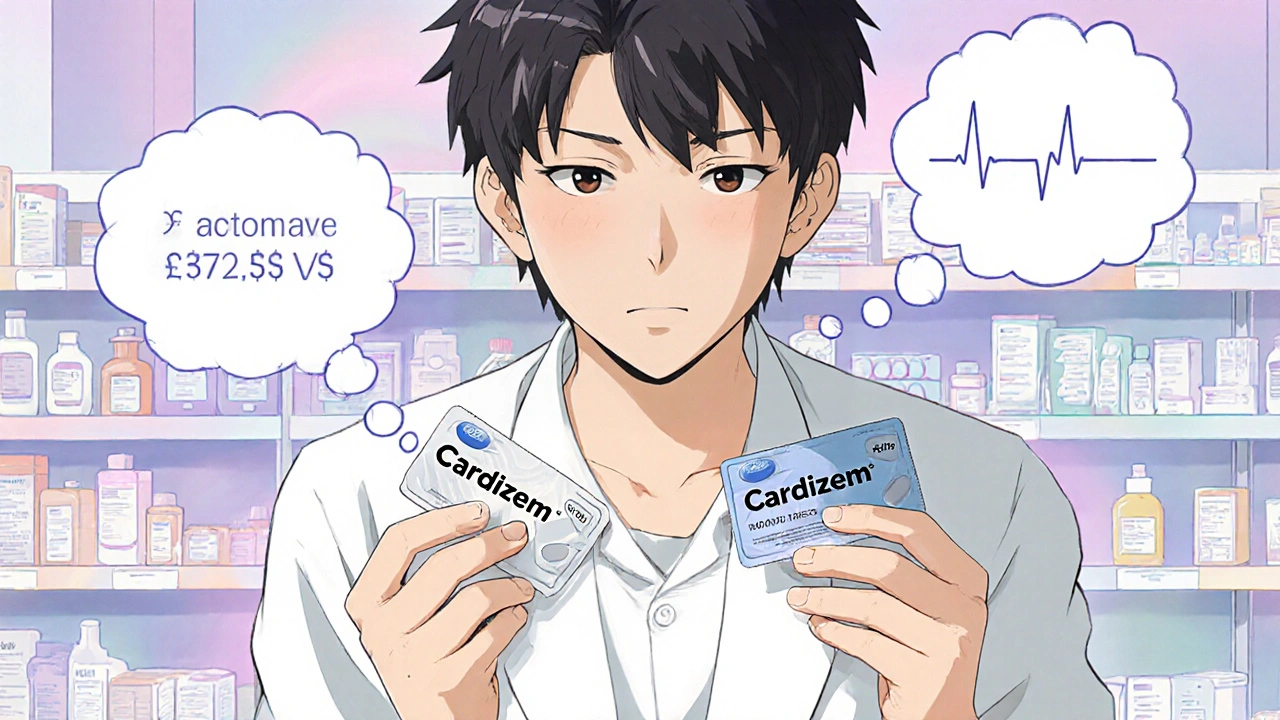Calcium Channel Blocker Comparison Tool
Select Your Medical Situation
Your Medication Comparison
| Medication | Edema Risk | Constipation Risk | Bradycardia Risk | Interaction Risk |
|---|---|---|---|---|
| Cardizem (Diltiazem) | 10-15% | 3-5% | 4-7% | High (CYP3A4 inhibitor) |
| Amlodipine | 15-20% | 1-3% | ≤1% | Medium |
| Verapamil | 5-10% | 8-12% | 6-10% | High (CYP3A4 inhibitor) |
| Nifedipine | 25-30% | 2-4% | ≤1% | Medium |
| Felodipine | 12-18% | 2-5% | ≤1% | Low |
Your Recommended Option
Why this is best for you: Based on your medical condition, concerns, and current medications, this medication has the optimal balance of efficacy and safety for your specific situation.
When doctors prescribe a blood‑pressure or heart‑related drug, they often start with the familiar name Cardizem. But is it always the best fit? Below we break down how Cardizem (diltiazem) stacks up against its most common alternatives, so you can see where it shines and where another option might suit you better.
What Is Cardizem (Diltiazem)?
Diltiazem is a non‑dihydropyridine calcium channel blocker marketed under the brand name Cardizem. It works by relaxing the smooth muscle in blood vessels and slowing the electrical conduction through the heart’s AV node. This dual action makes it useful for treating hypertension, angina, and certain types of atrial fibrillation.
How Calcium Channel Blockers Work
All calcium channel blockers (CCBs) interfere with calcium ions entering cardiac and vascular muscle cells. By limiting calcium influx, they reduce muscle contraction, which lowers blood pressure and eases the heart’s workload. There are two main subclasses:
- Non‑dihydropyridines (e.g., diltiazem, verapamil) - affect both vessels and the heart’s electrical system.
- Dihydropyridines (e.g., amlodipine, nifedipine) - primarily dilate arteries with minimal direct cardiac effect.
Major Alternatives to Cardizem
Below are the most frequently considered substitutes, each with its own strengths.
1. Amlodipine
Amlodipine is a dihydropyridine calcium channel blocker approved for hypertension and chronic stable angina. Its long half‑life (30‑50 hours) allows once‑daily dosing, which can improve adherence.
2. Verapamil
Verapamil is a non‑dihydropyridine CCB that, like diltiazem, reduces heart rate and contractility. It’s especially effective for supraventricular tachycardia but carries a higher risk of constipation.
3. Nifedipine
Nifedipine is a rapid‑acting dihydropyridine often used for acute hypertensive crises. Extended‑release formulations are also common for chronic therapy.
4. Felodipine
Felodipine is another dihydropyridine known for a smooth blood‑pressure‑lowering profile and minimal reflex tachycardia.

Side‑Effect Profile Comparison
Side effects drive many prescribing decisions. Here’s a quick look at how each drug typically fares.
| Side Effect | Diltiazem (Cardizem) | Amlodipine | Verapamil | Nifedipine | Felodipine |
|---|---|---|---|---|---|
| Peripheral edema | 10‑15% | 15‑20% | 5‑10% | 25‑30% | 12‑18% |
| Headache | 8‑12% | 10‑14% | 7‑11% | 15‑20% | 9‑13% |
| Constipation | 3‑5% | 1‑3% | 8‑12% | 2‑4% | 2‑5% |
| Bradycardia | 4‑7% | ≤1% | 6‑10% | ≤1% | ≤1% |
| Flushing/Hot flashes | 2‑4% | 1‑3% | 2‑5% | 5‑9% | 3‑6% |
Notice how dihydropyridines such as nifedipine tend to cause more edema, while non‑dihydropyridines like verapamil bring constipation and bradycardia into the mix.
Drug‑Interaction Considerations
Because many CCBs are metabolized by the liver enzyme CYP3A4, they interact with a host of other medicines. Below are key points for each drug.
- Diltiazem: Strong CYP3A4 inhibitor; raises levels of statins (e.g., simvastatin), certain anti‑arrhythmics, and some antivirals. Dose adjustments often needed.
- Amlodipine: Moderate CYP3A4 substrate; fewer serious interactions, but watch for concurrent use with strong inhibitors like ketoconazole.
- Verapamil: Potent CYP3A4 inhibitor, similar to diltiazem; can increase concentrations of digoxin, beta‑blockers, and certain benzodiazepines.
- Nifedipine: Also a CYP3A4 substrate; avoid combining with grapefruit juice, which can boost plasma levels dramatically.
- Felodipine: Metabolized by CYP3A4; interactions mirror those of amlodipine, though the risk of severe interaction is slightly lower.
Always check with a pharmacist before adding new prescriptions or over‑the‑counter products.
Cost and Availability
Cost can be a deciding factor, especially for patients without insurance coverage.
| Drug | Brand Name | Generic | Typical Monthly Cost* |
|---|---|---|---|
| Diltiazem | Cardizem | Yes | $12‑$25 |
| Amlodipine | Norvasc | Yes | $8‑$20 |
| Verapamil | Calan | Yes | $10‑$22 |
| Nifedipine | Procardia | Yes | $9‑$19 |
| Felodipine | Plendil | Yes | $11‑$23 |
*Prices based on average retail rates for a 30‑day supply of standard dosages (2025). Insurance coverage, coupons, and pharmacy discounts can shift these numbers.

Choosing the Right Medication: Decision Guide
Here’s a quick checklist to help patients and clinicians decide when Cardizem is appropriate versus an alternative.
- Primary indication: If controlling heart rate in atrial fibrillation is a priority, Cardizem or Verapamil are preferred over dihydropyridines.
- Risk of edema: For patients prone to swelling, avoid nifedipine; consider Cardizem or felodipine.
- Drug‑interaction load: If the patient already takes multiple CYP3A4 substrates, amlodipine or felodipine may be safer choices.
- Adherence factor: Once‑daily dosing (amlodipine, felodipine) simplifies regimens compared to multiple daily doses of some Cardizem formulations.
- Cost considerations: Generic diltiazem is cheap, but insurance formularies may favor other generics.
Using this framework, clinicians can tailor therapy to the individual’s health profile rather than defaulting to a single brand.
Patient Stories: Real‑World Outcomes
Maria, 58, hypertension - “I switched from Cardizem to amlodipine because I kept getting ankle swelling. The swelling disappeared within two weeks, and my blood pressure stayed steady.”
James, 67, atrial fibrillation - “My doctor chose diltiazem over a beta‑blocker because I smoke and couldn’t tolerate the fatigue. It slowed my heart rate without making me feel wiped out.”
These anecdotes illustrate why a one‑size‑fits‑all approach rarely works in cardiovascular care.
Key Takeaways
- Cardizem (diltiazem) uniquely balances vascular dilation with heart‑rate control.
- Dihydropyridines (amlodipine, nifedipine, felodipine) excel at pure blood‑pressure reduction but may cause more edema.
- Verapamil offers similar heart‑rate effects as diltiazem but carries higher constipation risk.
- Consider drug interactions, dosing convenience, side‑effect tolerance, and cost when picking a therapy.
Can I take Cardizem and a statin together?
Yes, but you may need a lower dose of certain statins like simvastatin. Diltiazem slows the metabolism of some statins, raising their blood levels and the risk of muscle side‑effects. Talk to your pharmacist about dose adjustments.
Is Cardizem safe during pregnancy?
Diltiazem is classified as Pregnancy Category C. It should only be used if the potential benefit justifies the potential risk to the fetus. Always discuss alternatives with your obstetrician.
What’s the difference between Cardizem and Cardizem CD?
Cardizem CD is the extended‑release capsule, taken once daily, while regular Cardizem is an immediate‑release tablet usually dosed 2‑3 times per day. The CD version provides smoother blood‑pressure control but may take longer to reach full effect.
Can I switch from Cardizem to a dihydropyridine without a doctor’s order?
Never change prescription drugs on your own. Switching class changes both how the drug works and its side‑effect profile, so a clinician must evaluate your heart rhythm, blood‑pressure goals, and other meds.
How quickly does Cardizem start working?
Oral diltiazem usually begins to lower blood pressure within 30‑60 minutes, with peak effect at 2‑3 hours. The extended‑release form reaches steady state after about 5‑7 days.





Tim Blümel
October 22, 2025 AT 20:59Cardizem feels like the Swiss‑army knife of CCBs 😊
Harini Prakash
October 23, 2025 AT 19:20Reading this breakdown really helps demystify why a doctor might pick one CCB over another. The side‑effect table is especially handy – I didn’t realize how much edema varies. It’s good to see the cost info too; many patients overlook that. Thanks for the thoroughness! ;)
Benedict Posadas
October 24, 2025 AT 17:40Wow, this is super helpful – I was always confused about when to use Cardizem vs amlodipine. The part about CYP3A4 interactions hits home, cause I read about simvastatin issues. Also, the patient story about ankle swelling made me nod. Great job summarizing the data, really appreciate it! 😄
Sameer Khan
October 25, 2025 AT 16:00The pharmacodynamic nuances outlined here are cogent and align with contemporary guideline recommendations. Notably, the delineation between non‑dihydropyridine and dihydropyridine agents underscores differential nodal effects on the AV conduction system. The tabulated adverse-event frequencies provide a quantitative scaffold for shared decision‑making. Moreover, the CYP3A4 substrate/inhibitor dynamics merit vigilant therapeutic drug monitoring. In practice, this granularity can mitigate iatrogenic complications.
Kiara Gerardino
October 26, 2025 AT 13:20Honestly, the layperson often gets tossed a brand name without understanding the stakes. Cardizem’s dual action can be a lifesaver, but the edema risk isn’t a trivial footnote. If you’re not willing to sift through the data, you might end up on a drug that worsens quality of life. Physicians should wield this knowledge like a scalpel, not a hammer.
Suryadevan Vasu
October 27, 2025 AT 11:40Diltiazem’s balanced vascular and cardiac effects make it versatile. However, patient-specific factors dictate the final choice.
Vin Alls
October 28, 2025 AT 10:00What a masterclass in comparative pharmacology!
First, the tableau of side‑effects reads like a vivid palette, each hue representing a clinical nuance that can tip the scales.
Second, the pharmacokinetic interplay with CYP3A4 is a reminder that drugs rarely act in isolation; they dance in a crowded metabolic ballroom.
Third, the cost breakdown demystifies the economic backdrop, essential for patients navigating insurance labyrinths.
Fourth, the decision‑guide checklist is a pragmatic compass, steering clinicians away from one‑size‑fits‑all prescriptions.
Fifth, the patient anecdotes inject humanity into the data, reminding us that behind every pill lies a lived experience.
Sixth, the distinction between immediate‑release and extended‑release formulations of Cardizem underscores the importance of dosing convenience versus onset speed.
Seventh, the comparison of edema prevalence across agents highlights that a seemingly minor side‑effect can be a deal‑breaker for those prone to swelling.
Eighth, the concentration on bradycardia risk with non‑dihydropyridines underscores why vigilant ECG monitoring remains paramount.
Ninth, the mention of grapefruit juice’s impact on nifedipine is a tasty reminder of diet‑drug interactions.
Tenth, the nuanced discussion on statin compatibility with diltiazem equips prescribers to avoid myopathic pitfalls.
Eleventh, the emphasis on drug‑interaction vigilance serves as a clarion call for interdisciplinary collaboration with pharmacists.
Twelfth, the narrative threads weave a tapestry where efficacy, safety, adherence, and economics converge.
Thirteenth, the layered analysis empowers patients to engage in shared decision‑making with confidence.
Fourteenth, the systematic layout makes the content digestible, even for non‑clinicians.
Fifteenth, the overarching theme celebrates individualized therapy, a cornerstone of modern medicine.
Sixteenth, kudos to the authors for translating complex science into an accessible, actionable guide.
Tiffany Davis
October 29, 2025 AT 08:20This summary is concise and well‑structured. I’ll keep it handy for future reference.
Don Goodman-Wilson
October 30, 2025 AT 06:40Oh great, another glorified drug brochure. As if we needed more hype around a calcium channel blocker. Guess the pharma sales execs finally got a piece of the action.
Bret Toadabush
October 31, 2025 AT 05:00Sure, the article looks legit, but have you considered the hidden agenda? Big pharma loves to bury the truth about long‑term cardiac damage. They’ll push you to take Cardizem while they monitor you from the shadows. Stay woke.
Diane Thurman
November 1, 2025 AT 03:20Interesting perspective.